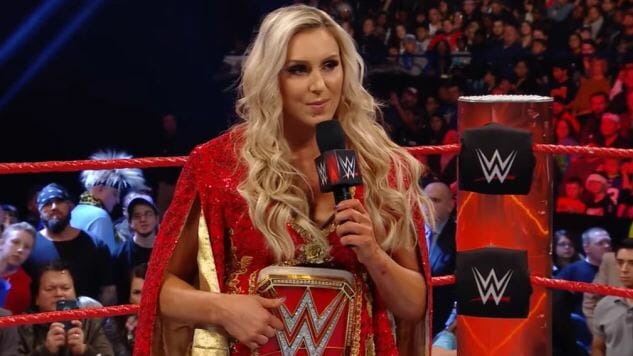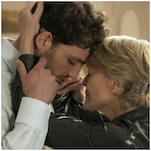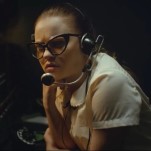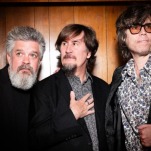WWE’s Women’s Divisions Are a Lot More Like Traditional Pro Wrestling Than the Men’s

Since WWE revived the brand extension in July, a pattern has emerged: The women’s title feuds are the highlight of each show. On Raw, this wasn’t necessarily surprising, in the sense that the red brand got the bulk of the “women’s revolution” talent. The booking elevated the division, though, with stronger angles than the other main feuds were getting. On Smackdown, where the consensus was the blue team got the weaker roster, the women have arguably been even better: Nikki Bella’s programs, first with Carmella and now with Natalya, greatly over-delivered, while the Becky Lynch-Alexa Bliss title feud has arguably been one of the best things in WWE for months.
How did we get here? What is WWE doing differently? Most of it is absolutely due to the performances by WWE’s female talent. But the beats of their storylines have also been significantly better than most of the others on the main roster.
On top of overall match quality, the women’s matches have been the most violent matches in the promotion in recent months, contrary to their role historically in WWE. Think about some of the most memorable moments from the women’s division in the last six months: Charlotte Flair repeatedly ragdolling Sasha Banks into a table at Hell in a Cell; Nikki Bella giving Carmella a black eye; Banks and Alexa Bliss half looking like they were shooting on each other during their brawl right before Survivor Series; Natalya and Bella’s merchandise stand brawl; Banks winning the title from Flair in a falls count anywhere match with a banister-assisted Bank Statement; Flair destroying Banks’ knee to regain the title. And so on.
It’s not just dramatically more violent than the women’s matches used to be, but it’s more violent than even the men’s matches now. That harder edge makes the women’s matches stand out more, and the difference from the past incarnations of the women’s division makes it seem even more gnarly than it would in a vacuum.
WWE’s women’s division has gone through a few distinct phases over the years. Through the late 1980s, the title was usually controlled by the Fabulous Moolah, with the division dominated by the students from her school in South Carolina. While she did have some standout pupils like Leilani Kai, Judy Martin, Princess Victoria and Velvet McIntyre, they were the exception rather than the rule. The Moolah-style match was the opposite of violent, based around overly choreographed offense that usually involved hair pulling and Moolah herself hiding foreign objects from the referee. There was no “there” there, which was the opposite of women’s wrestling before Moolah took over, where the women worked a hard style just like the men.
In the mid-1990s, with Alundra Blayze as champion, the idea was primarily to have her work with wrestlers who could do the Japanese women’s style, since that’s where she excelled. She had good—albeit disappointing—matches with an obviously toned down Bull Nakano, bad matches with a past-her-prime Bertha Faye, and was set to feud with Aja Kong when the company dropped the division. Perhaps not coincidentally, that decision came right after Kong broke Chaparita Asari’s nose with a spinning backfist on Monday Night Raw.
And if you’re reading this, you likely know what the next era of the women’s division was: The one that was launched under Sable, with short bra-and-panties matches used as a distraction, even when both the female talent could wrestle and the fans wanted more.
There’s a real, pronounced difference now, both from the men and from the women who came before them, one that also extends to creative. Watch Raw and, to a lesser extent, SmackDown closely for a few weeks and you’ll notice a pattern: WWE doesn’t really shoot angles anymore, at least as we know them from decades of professional wrestling. Instead, things happen according to a few strict templates: Talking segment leads to match being made by authority figure; Match ends with run-in or entrance music distraction; Talking segment leads to an attempt at comedy; Wrestler A attacks Wrestler B during a backstage interview. You get the gist. You might occasionally get something like the Enzo-Lana-Rusev skit, but that’s about it.
In the women’s divisions (and some of the men’s feuds on SmackDown), there are a lot more traditionally structured pro wrestling angles. Charlotte Flair “apologizing” to her dad as a setup to trap Sasha Banks was a great angle. Becky Lynch posing as “La Luchadora” to one-up Alexa Bliss is a time-honored, classic pro wrestling angle that’s been done for decades. Carmella blindsiding Nikki Bella out of nowhere on the Talking Smack set and Nia Jax attacking Sasha Banks while her knee was getting checked out before the show were similarly simple, but effective pro wrestling angles. Even Natalya taunting Bella from the upper deck and then the merchandise stand, leading to a brawl that took them through one of the stand’s tables, was structured much more like a traditional angle than the usual WWE talking-into-physicality segments.
With a few exceptions, everything else is a boring, overly civil talking segment shoehorned into the obnoxious WWE structure. Bitter enemies stand across from each other and politely take turns talking. It’s neutered, repetitive, and hard to watch. The women (and, more and more, the other wrestlers on SmackDown) come off as more interesting because they’re able to be in more complex and less rote situations. Throw in more violent and passionate matches, and you get something that feels a lot more like pro wrestling than the overly micromanaged WWE template product.
For a long time, the women in WWE were frustrated that they were told that they shouldn’t wrestle like the men, in good, athletic, heated matches. Instead, their job was to be a sideshow. Now? They’re not just “wrestling like the men.” They’re doing pro wrestling better than the men.
David Bixenspan is a freelance writer from Brooklyn, NY. You can follow him on Twitter at @davidbix and view his portfolio at Clippings.me/davidbix.






































